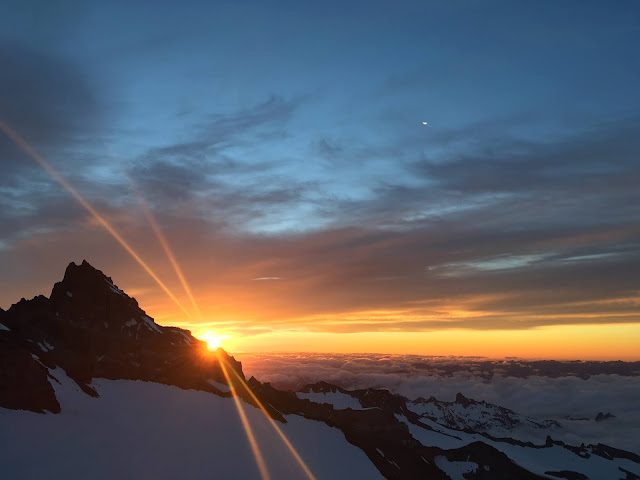 |
| Ranger on rappel from the Kautz Ice Chute |
The Kautz ice chute is in nice form for some late season tool swinging. Rangers from the park went on a patrol on 8/23/2021, detailed below is an account of what they found along their route.
Approach Via Comet Falls and Van Trump Park
Comet Falls trailhead is an alternative start to climbing one of the more popular climbing routes to the top of Mt. Rainier, the Kautz Glacier. For our patrol, the Paradise approach seemed more hazardous in the late season conditions and we opted for the Van Trump Park approach option.
While longer and more elevation to surmount via this approach, there are certainly pros to the Comet Falls trail start. First, you will notice the waterfalls cascading along the trail for the first 1.6 miles to the Comet Falls viewpoint. If you have not seen Comet Falls before, you are in for a treat. Second, above the Comet Falls viewpoint your level of solitude is sure to increase. The occasional day hiker will press on from the falls to Van Trump park, but on this patrol they were few and far between.
 |
| Rangers descending toward Van Trump Park |
Snowfields and Scree
Above Van Trump Park (5,500') the unmaintained trail ascends a defined ridge trail before giving way to the scree and talus above. The trail trends N by NE and around 7,000' you begin to move between sections of rock and snow up to approximately 7,800'. From here a consistent bit of snow travel along the upper Van Trump Glacier will put you into the 9,400' elevation zone. Trending East across the rock band below the Turtle from here allowed our team to find running water and camping options numerous enough to set up camp out of the wind.
 |
| Sunset from near the Lower Castle camp around 9,400' |
The Castle Area
The castle area, lower and upper, from approximately 9,250'-9,500' are common areas for teams to make camp. In the afternoon we arrived, there seemed to be an abundance of running water in this zone, and many options for camping. As the sun sets expect the water sources to reduce in flow significantly.
The Turtle
The two approach trails to the Kautz merge at 9,800' at the base of The Turtle. The slope of the lower turtle is approximately 45 degrees and in early season this feature can be efficiently navigated traveling on snow. We found the turtle had melted down to glacial ice, which increased the risk and slowed our travel. The icy conditions and exposure to ice and rockfall could be mitigated by staying along the western side of the terrain where the angle was slightly less steep, and the exposure to rock and ice fall was reduced. Climbing this features covers the elevation from 9,800' - 10,800' where a trail through the loose rock of the Wapowety Cleaver leads the climber to more camping options just below Camp Hazard and next to the rock step or rappel that must be descended to get into the ice chute at around 11,300'.
 |
| Looking at the upper portion from the lower section of the ice chute. |
Kautz Ice Chute
To get to the ice climbing there is a rock step which must be descended. Rangers found there to be doubled, fixed static climbing ropes anchored at the step. Knots tied along the ropes would not allow the climber to rappel these ropes, but when utilized as master points to clip into with a personal anchor or a tether coming off the harness, they were helpful. At the base of the step a loose rock trail, above exposed terrain must be traversed to get onto the glacier where you traverse yet further under an area of ice fall potential with small crevasses that need to be negotiated. Moving beyond this hazard zone puts one into the ice chute and teams can pick out their line of attack from there. On 8/23 rangers found the ice pitches to be approximately two 400-450' sections, a lower and an upper section, separated by a patch of lower angle snow between the sections. The lower section was at approximately 50 degrees and the upper portion 70 degrees. Good, Fun ice climbing ensued!
For a more detailed look at the route, check out the Kautz Glacier Routebrief.
























